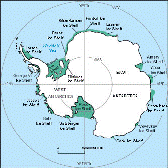Antarctic Drilling Program (ANDRILL)

ANDRILL Related Publications of Affiliates
Document Type
Article
Date of this Version
2007
Abstract
Gold mineralization is associated with the paleo-Pacific margin of Gondwana and is related to processes of subduction/accretion and magmatism. Northern Victoria Land (Antarctica) was part of this margin during the Paleozoic, however no occurrence of gold has been reported up to now in the Transantarctic Mountains. Here we describe for the first time gold-bearing quartz veins in northern Victoria Land. The veins are hosted primarily by metabasalts and occur in a brittle-ductile high strain zone with curved geometry and reverse kinematic. Veins are extensional and shear veins; they often have ribbon/banded texture typical of crack and seal processes. Preliminary petrographic investigations point to strong hydrothermal alteration with growth of chlorite + quartz and then of sericite + carbonates + sulphides approaching the vein. Available data are discussed with the aim to understand the origin of the gold deposit and to frame it in the regional tectonic evolution.


Comments
Citation: Crispini, L., G. Capponi, L. Federico, and F. Talarico (2007), Gold bearing veining linked to transcrustal fault zones in the Transantarctic Mountains, in Antarctica: A Keystone in a Changing World - Online Proceedings of the 10th ISAES, edited by A.K. Cooper and C.R. Raymond et al., USGS Open-file Report 2007-1047, Extended Abstract 212, 4 p.